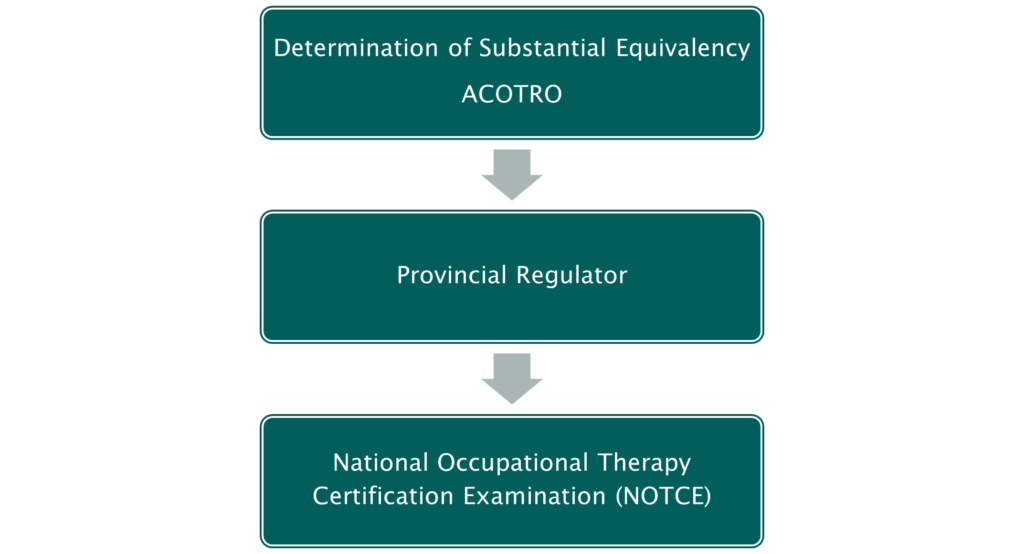
SUBSTANTIAL EQUIVALENCY ASSESSMENT SYSTEM
This section will introduce internationally educated occupational therapists (IEOTs) to the Substantial Equivalency Assessment System (SEAS) and provide an overview of the registration process, as well as information about SEAS program outcomes.
It is important to know that IEOTs planning to work in the Province of Quebec need to contact L’Ordre des ergothérapeutes du Québec (OEQ) (the College of Occupational Therapists of Quebec) and will be required to complete an OEQ program of review and not the SEAS program.
An Introduction to SEAS
If you are an internationally educated occupational therapist (IEOT) and wish to work as an occupational therapist (OT) in Canada, you must first complete the SEAS program.
The Association of Canadian Occupational Therapy Regulatory Organizations (ACOTRO) launched the SEAS program on May 1, 2015, to provide a single, centralized process for the assessment of educational qualifications and competencies of IEOTs. SEAS determines whether the education and competencies of IEOTs are substantially equivalent to Canadian-educated occupational therapists.
- Substantially equivalent means that an IEOT’s qualifications and competence are equivalent to that of a Canadian-educated OT. The SEAS process determines if substantial equivalency has been met.
Registration Process at a Glance
SEAS is the first step to becoming registered to practice as an OT in Canada. IEOTs who meet substantial equivalency through SEAS can then apply for registration/licensure with one of the provincial regulators in Canada. After successfully completing the registration process, the provincial regulator will provide the IEOT with permission to write the National Occupational Therapy Certification Examination (NOTCE), which is a step in obtaining full licensure to practice in Canada.

Currently, all SEAS assessments are conducted remotely. Therefore, you do not have to be in Canada to participate in the SEAS program.
SEAS Program Outcomes
Once an IEOT has completed all the SEAS assessments, a determination will be made as to whether or not they have met substantial equivalency. There are three possible outcomes of the SEAS process:
- Substantial equivalency has been met.
The IEOT will receive a certificate of substantial equivalency and is eligible to apply for registration with a provincial regulator. - Substantial equivalency has not been met; however, substantial equivalency will be achieved with successful completion of gap-filling activities.
Upon successful completion of gap-filling requirements, the IEOT will receive a certificate of substantial equivalency and be eligible to apply for registration with a provincial regulator. - Substantial equivalency has not been met. Gaps in education and/or competencies are numerous and significant and would not be adequately addressed with gap-filling.
The IEOT will NOT receive a certificate of substantial equivalency.
FAQs
How were IEOTs assessed prior to SEAS?
Prior to SEAS, there were differences in the way the Canadian provincial regulators assessed IEOT applications. In 2010, ACOTRO launched an initiative to harmonize the way in which Canadian regulators assessed IEOTs applying to practice in Canada. The result of this initiative was SEAS, a national competency-based system that assesses the extent to which the education and competencies of IEOTs are substantially equivalent to those of Canadian-educated OTs.
SEAS offers a fair, transparent, objective, and consistent approach to assessing IEOTs that, ultimately, better protects the health of Canadians by ensuring that IEOTs have demonstrated the minimal level of competencies critical for safe, effective, and ethical occupational therapy practice in Canada. As a national assessment system, SEAS also supports the labour mobility of IEOTs throughout Canada.
Will SEAS let the Canadian Association of Occupational Therapists (CAOT) know when I can write the NOTCE?
SEAS determines whether an IEOT’s education and competencies are substantially equivalent to Canadian educated OTs; it does not determine eligibility to write the NOTCE. Your provincial regulator will advise CAOT of eligibility to write the NOTCE.
I already attempted the NOTCE prior to 2015 but did not pass. Can I complete the SEAS process and then attempt the NOTCE again?
SEAS does not determine eligibility to write the NOTCE. If you have already attempted the NOTCE but were not successful, please contact the provincial regulator in the province in which you plan to register to confirm how many attempts at the NOTCE you will be permitted. It is important that you do this prior to applying to the SEAS program.
Can I start the SEAS program before I finish my OT education?
To meet the academic qualifications to practice as an OT in Canada, all IEOTs must have obtained a minimum of a bachelor’s level degree in an occupational therapy program. If you start the SEAS program before finishing your OT education, you will not meet the minimum academic requirements.
How long do I have to complete the SEAS program?
IEOTs have 12 months to complete the SEAS program. After you complete the initial application process, you will be advised of your official SEAS start date and one-year expiration date. Your start date is determined by the date that SEAS receives your World Education Services (WES) credentials report, your completed application form, and payment of the application fee. You must complete all SEAS assessment activities and receive your Determination Report prior to your expiration date.
SEAS understands that there may be extenuating circumstances that may affect your ability to complete SEAS within 12 months. IEOTs may request a maximum of two extensions. Each extension is 12 months for a total maximum three-year timeline to complete SEAS. There is an administrative fee to request an extension.
Although IEOTs may request two 12-month extensions to their SEAS timeline, it is recommended that the IEOT contact the provincial regulator in the province in which they plan to practice to understand if the extension periods will impact their ability to meet registration requirements, such as currency hours.
If I am required to complete gap-filling to achieve substantial equivalency, do I have to complete this within the maximum three-year SEAS timeline?
The time required to complete any gap-filling is not included in the three-year SEAS timeline. You have one year from the date of your Determination Report to successfully complete any gap-filling requirements.
Am I required to apply to a provincial regulator immediately after completing SEAS?
If you meet substantial equivalency (either after meeting the minimal requirements of SEAS, or after successfully completing gap-filling requirements), you will be issued a Certificate of Substantial Equivalency. This certificate is valid for three years for the purpose of eligibility to apply for registration with a provincial regulator.
If you do not apply for provincial registration at the time you complete SEAS, it is recommended that you contact the provincial regulator to understand if this may impact your ability to eventually meet registration requirements, such as currency hours.
